| |

Hedgehog by Adam
© 2006 |
| |
Hedgehog, common name for any of several spiny mammals that are
similar in appearance to the porcupine, but more closely related to the mole.
The hedgehog, which is found in Europe, Asia, and Africa, has a coat of long,
stiff, pointed spines on its back. The fur on its underside is soft. Hedgehogs
average 25 cm (10 in) in length and range in color from light tan to black.
They have pointed snouts, small eyes, short legs. When threatened, the hedgehog
rolls itself into a ball. Hedgehogs conceal themselves in hedgerows during the
daytime and emerge at night to hunt. They eat insects, worms, frogs, snakes,
mice, and birds' eggs. European hedgehogs hibernate during the wintertime. In
July or August the European hedgehog gives birth to four to eight young.
|
| |
|
| |

Fly by Adam
©
2006 |
| |
|
| |

Leopard by Alex
© 2006 |
Baby leopards growl when playing.
Daddy leopard goes out slaying.
Daddy leopard attacks so fierce
Chasing buffalo and deer
Mammy leopard goes out prowling,
While the
cubs still are growling. |
| |
The leopard is the third largest cat of the eastern hemisphere.
Only the lion and the tiger are larger than it. Leopards live in many, many
places such as Asia, Turkey, Korea, and Java, China and in Africa as far north
as the Sahara Desert .They also used to live in Europe in bygone days. Although
they may look a lot like the cheetah their body structure is completely
different .Although cheetahs are a lot faster, the leopard is the much better
hunter of the two. When leopards kill their prey they may bring it up to a tree
and store there till they are hungry. Most leopards' coats are a light tan
colour with black spots. Leopards that live in forests coat are slightly darker
than leopards that live in open plains and desert scrub. Black leopards
(otherwise known as panthers) coats are so dark that you cannot see the spots.
When in trees leopards attack monkeys or drop down on deer or antelopes passing
beneath the tree. Sometimes leopards raid nearby villages for their cattle,
goats and dogs. Occasionally leopards will attack humans, but they do this more
rarely than tigers. |
| |
|
| |

Duck by Alex
© 2006 |
| |
|
| |
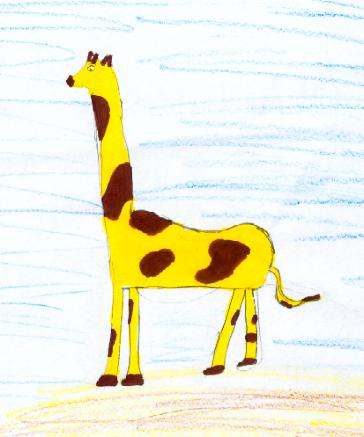
Giraffe by Aoife
© 2006 |
Giraffes are tall.
In Africa.
Running wild.
At their speed.
Fury from the lions.
Fury from the hyenas.
Eating
leaves from way up high.
Sun's heat makes them
sigh. |
| |
Giraffes are some of the hundreds of giant animals on land. No
two Giraffes have the same pattern of spots. In the wild Giraffes live about 25
years. Only male Giraffes engage in fights with other male Giraffe. Giraffes
usually sleep standing up. Giraffes can go weeks without drinking water. Their
long necks let them eat off the top of trees .Also male Giraffes necks are
longer than females' necks. |
| |
|
| |

Polar Bear by Becky
© 2006 |
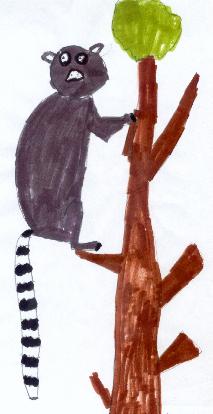
Lemur by Reece
©
2006 |
| |
Polar bears!
Arctic animals
have to survive freezing temperatures. Many have thick bushy white coats to
keep them warm and help them blend in with snow. Some have a layer of fat for
extra warmth. Polar bears claws are thick and curved. Each can measure more
than two inches (5.1 cm) long. |
Ring tailed lemurs
The island
of Madagascar is home to the ring tailed lemur. They have survived through very
bad times there. Lemurs use their tails in loads of different ways; they
balance themselves with their tails. When they walk along the ground they keep
their tail in the shape of a question mark, this insures that they know were
the other group are. The males use their tails to have stink fights. Whoever
has the strongest smell wins. There are fifty different types of lemurs. When
they jump through the air they appear to fly. You can find them nowhere else,
but in Madagascar. |
| |
|
| |

Kangaroo by Daniel
© 2006 |
| |
The kangaroo is a common marsupial from the islands of
Australia and New Guinea. There are 47 species of "roos". Kangaroos can hop up
to 40 miles per hour (74 kph) and go over 30 feet (9m) in one hop .These shy
animals live about 2 years in the wild and up to 20 in captivity. Most "roos"
are nocturnal (active at night). Many "roos" are in danger of extinction, but
they are also considered pest due to the way they damage crops. An adult male
is called a buck, boomer or jack; an adult female is called a doe, flyer, roo,
or jill. A baby is called a joey. A group of roos is called a mob. Females have
a pouch in which the young live and drink milk.
Diet: These herbivores (plant-eaters) eat grass, leaves, and
roots. They swallow their food without chewing it and later regurgitate a cud
and chew it. Roos need little water; they can go for months without drinking,
and they dig their own water wells. |
| |
|
| |

Tiger by Dylan
© 2006 |
| |
A Tiger belongs to the cat family. The Siberian tiger measures
11 to 13 feet long from his nose to the tip of his tail. This animal is the
largest of all the big cats. The background of a tiger coat is usually a bright
reddish orange op a pale yellow brown. The stripes that mark the body are
usually black. Like all cats tigers have sharp teeth and claws they can move
quickly and quietly. Springing with ease, tigers may cover 15 feet in one leap.
They rarely climb and they are good swimmers too. Tigers usually hunt alone at
night. To make a kill, the tiger leaps on the animal biting its neck. He then
takes the slain animal to some hidden spot. If it's a large animal, the tiger
may feed on it for several days. During this time he does not kill again.
Tigers eat deer, pig, cattle, goats, and some smaller animals. Tigers are only
found in Asia. |
| |
|
| |

Eagle by Jamie
© 2006 |
Eagles flying in the sky
Look
at them before they go by
Mind how close you
get
Because they will peck you I bet.
|
| |
An eagle lives for about 20 or 30 year. Eagles breed when they
are about 4. In winter eagles go to places with lots of food .Bald eagles are
white with reddish-brown feathers. There are 60 species of eagles. The bald
eagle is found in America. The golden eagle eats rabbits and squirrels.
|
| |
|
| |

Fly by Lauren
©
2006 |
| |
|
| |

Snake by LeeMc
© 2006 |
| |
Brazilian rainbow boas occur naturally across much of the
northern half of south America they were exported in fair numbers from Surinam
and the Guyana area during the eighties and nineties .In the wild the Brazilian
rainbow boas diet is rodents, birds and could be some forms of aquatic life and
lizards . They may live up to 20 years. |
| |
|
| |
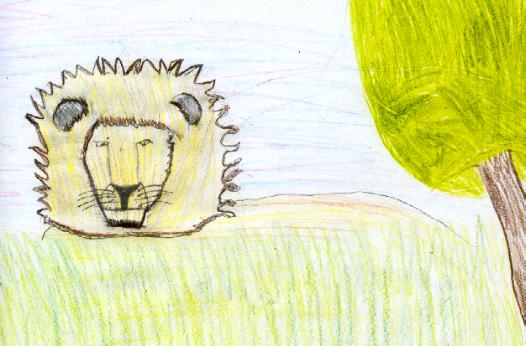
Lion by Michael By
© 2006 |
| |
During the hottest hours of the day the lions rest to avoid
over heating and keeping their hunting until cooler hours.Their prey is wild
boars, deer and antelope. Africa is the only place in the world with wild
lions. |
| |
|
| |
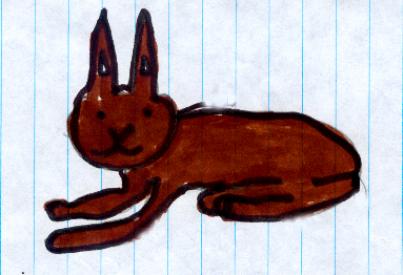
Rabbit by Michael G
© 2006 |
| |
Rabbits are small mammals and found in many parts of the world.
|
| |
|
| |
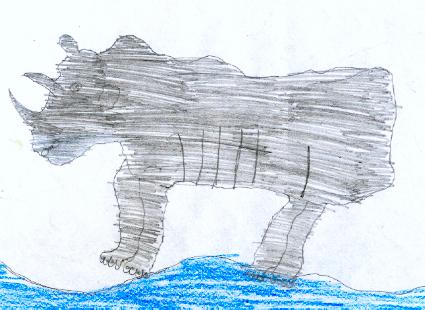
Rhino by Michael R
© 2006 |
| |
Rhinos can come in different sizes and colours. The most common
colours for a Rhino are grey, brown and black. There are also different types
of Rhinos such as the Black, White, Indian, Javan and the Sumatran. The
smallest Rhino is the Sumatran which can be found in Malaysia, Thailand and
some parts of Indonesia. The Sumatran's colour is a reddish brown The largest
Rhino is the White Rhino which can be found only in a few Southern states of
Africa. There are two horns, the front is bigger than the back.
|
| |
|
| |
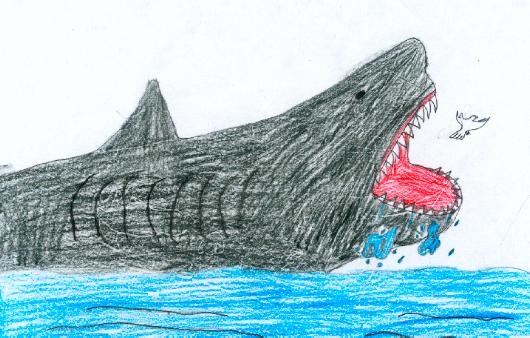
Shark by Niall
© 2006 |
| |
Sharks are found in nearly every sea of the world. Sharks are
carnivorous and will eat anything from plankton to even whales.The most
dangerous shark of all is the great white shark, sometimes known as the
man-eater .They grow up to 20 feet long and live in some cold waters. The
largest shark of all is the whale shark which lives in warm waters .although it
may reach a length of more than 15 metres and weigh several tonnes, it is quite
harmless. There are about 368 different species of sharks. |
| |
|
| |
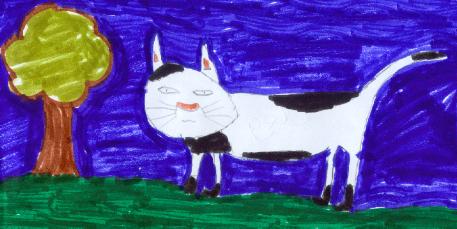
Cat by Oleg
©
2006 |
| |
It is valued by humans for its companionship and its ability to
destroy vermin. Intelligent, the cat can be trained to obey simple commands.
Cats have lived in close association with humans for at least 9,500 years. The
Egyptians believed that slim cats brought good luck.
Cats use more than one hundred vocalizations and types of body
language for communication, including mewing, purring, hissing, growling,
chirping, clicking, and grunting. Cats have even been observed mimicking the
calls of birds.
Unlike dogs and most mammals,
cats walk by moving both legs on one side and then both legs on the other. Cats
share this unusual gait with camels, giraffes, and only a few other mammals.
|
| |
|
| |

Crocodile by Penuel
© 2006 |
| |
Survivors of the dinosaur age, crocodiles are found in the
warmer waters of Africa, Asia, Australia, and America. Crocodiles are often
confused with alligators, but you can tell them apart by the shape of their
tapered snout, and by the way crocodiles' lower teeth stick out when their jaws
are closed.
Crocodiles vary in size. The
saltwater crocodile measures up to 10 m in length, while others are no more
than 1 m long. Hunted extensively for their skins, large crocodiles are
becoming increasingly rare. They eat fish, birds, and mammals, including the
occasional human. Crocodiles are cold-blooded. They like basking in the sun.
|
| |
|
| |
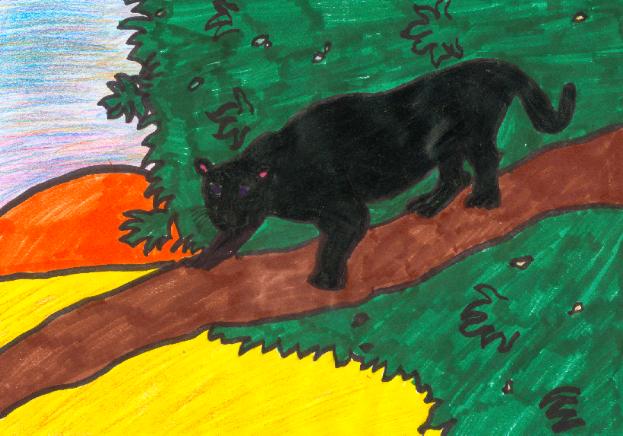
Jaguar by Ricardo
© 2006 |
| |
Jaguars are the largest cat in the western hemisphere. Black
jaguars live in South America. The jaguar symbolized strength and courage to
the ancient Maya Indians who considered the animal a god. |
| |
|
| |
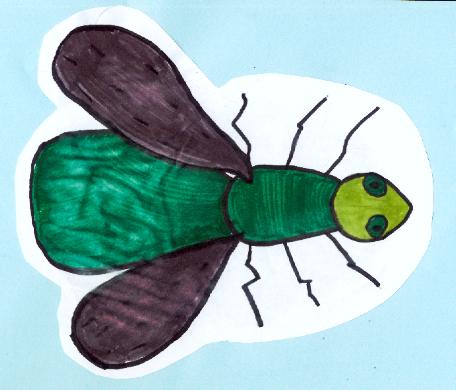
Fly by Robert M
© 2006 |
| |
|
| |
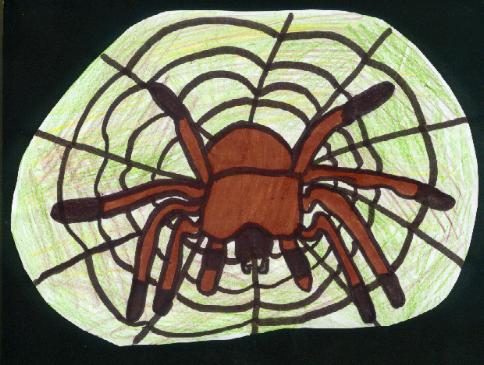
Tarantula by Robert
M
© 2006 |
| |
Tarantulas are the world's largest spider. The biggest ones
live in South American jungles. Great numbers of Tarantulas also are found in
the Southern United States. Many kinds of Tarantulas dig burrows or nests. A
California Tarantula builds a turret [small tower] out of grass and twigs at
the entrance to its burrow. This spider then sits on the tower watching for
insects in the nearby grass. And few Tarantulas live in trees. A bite from a
Tarantula is deadly to insects and can be extremely painful to a man.
Tarantulas can eat lizards, insects and even small birds. |
| |
|
| |
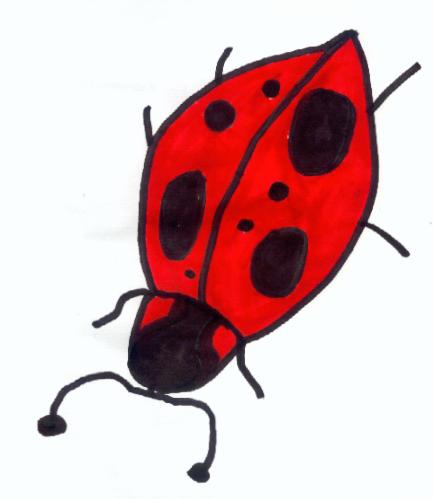
Ladybird by Stephen
© 2006 |
| |
|
| |

Panda by Stephen
© 2006 |
| |
Pandas are black and white and loved all over.
The giant panda is a national treasure in China and is
therefore protected by law. This unique bear has long been revered by the
Chinese and can be found in Chinese art dating back thousands of years. The
length of a panda is about 5 feet (1.5meters). Pandas live to about 14 to 20
years in the wild but in managed care they can live up to 30 years.
Did you know?
Giant pandas are technically Carnivores, but they have adapted
to the life of herbivores eating around 10 kgs of bamboo a day. If bamboo is
scarce they will turn to eating chickens and small rodents. |
| |
|
| |

Spider by Shannon
© 2006 |
| |
Spiders are not insects like some people think they are, but
they are arachnids. Black widow spiders are very timid spiders and are not
known to aggressively bite humans. After being bitten by a black widow one may
feel painful rigidity in the muscles of the abdomen and a feeling of tightness
in the chest. |
| |
|
| |

Whale by Barbara
© 2007 |
| |
In the Antarctic whale diet is plankton, marine mammals, fishes
and squids. Female whales weigh as much as 32 elephants. The heart is the same
size of a car. Killer whales normally eat seals. |
| |
|
| |
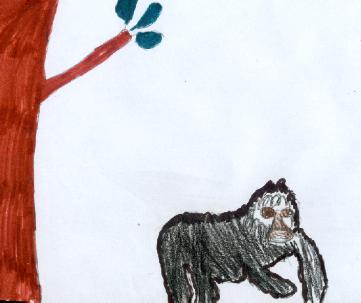
Gorilla by RobertL
© 2007 |
| |
Gorillas are found in places like Africa. The colour of their
fur is black and they eat Leaves, shoots and stems. They are in danger of
becoming extinct. |
| |
|
| |

Lynx by Sam
©
2007 |
| |
They are mainly nocturnal. Their kittens are born in May and
June. |
| |
|
| |
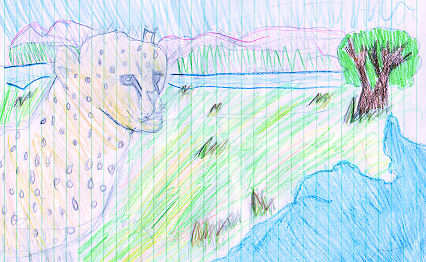
Cheetah by
Nicole
© 2007 |
| |
Unlike most animals humans apply the name cheetah to both
female and male. The average life span of wild radio-collared female cheetahs
is 6.9 years. The cheetah is said to be the fastest animal in the world. This
wild animal, who lives in the southern Sahara in Africa, hunts by day. Compared
to other members of the cat family the cheetah does not approach its prey
stealthily, nor does he jump on it, but runs after it and chases it. Its main
source of food is antelope and deer. An antelope can also run very fast up to
100km per hour, giving it a chance to escape from the cheetah. Cheetahs run
fast, but they cannot last for long. The body of the cheetah is adapted for
taking prey by running rather than leaping from ambush, and the cheetah hunts
by sight rather than by smell. Over short distances it is the fastest ground
animal on earth, being able to attain speeds up to about 110 km/h It hunts by
day, feeding mainly on antelope. The cheetah was formerly trained and used for
hunting in Asia, Libya, and India; it is now extinct or endangered in much of
its range. In tropical Africa, where it lives on open plains, the cheetah is an
endangered species. |
| |
|
| |
Dolphin by Niamh |
| |
Dolphins are whales. Dolphins often swim together in groups
called schools. Sometimes they jump out of the water. The name "dolphin"
belongs to part of the whale family, and so dolphins are mammals. Most dolphins
are less than 10 feet long, with sharp teeth and rather pointed jaws. The head
seems to have a beak Dolphins are prey to sharks. Dolphins eat fish and squid.
Dolphins have a maximum life span of 25 years. Dolphins are in no danger as
their numbers are abundant. Dolphins breath air. They can jump 20 feet or 6
metres out of the water into the air. Dolphins live in small pods of up to 12
dolphins, they are very social animals. |
| |
|
| |
Lizard by LeeG |
| |
Lizards are reptiles a class of animals that also includes
turtles and snakes. There are 3000 kinds of lizards. Some lizards look like
dragons others look like worms like snakes.One of the dragon kind of lizards is
called a komodo monitor - the largest lizard. A typical lizard is four legged
short bodied and long-tailed. All lizards shed their scaly skins.
|
| |
|
| |
Chimpanzees by Lauren |
| |
Chimps spend most of their time on the ground where they both
walk and run on two legs. Chimpanzees can be told from other monkeys from their
large hairless ears. They weigh slightly less then most humans. They are able
to lift or move objects that a strong man can not even budge. Chimpanzees are
considered the most intelligent of the apes in captivity. Chimpanzees are
covered with black hair on most of their body (except their fingers, palms,
armpits, and bottoms of their feet). |
| |
|
| |
Dogs by Amy |
| |
A lot of people think a dog is dumb put dogs can sense if a
storm is coming like an earthquake or a volcano. Their fur keeps them warm in
the winter. In summer a dogs fur turns brighter, in winter its fur turns dark.
If you train a dog don't do it in the morning or when its excited or
tired. |
| |
|































